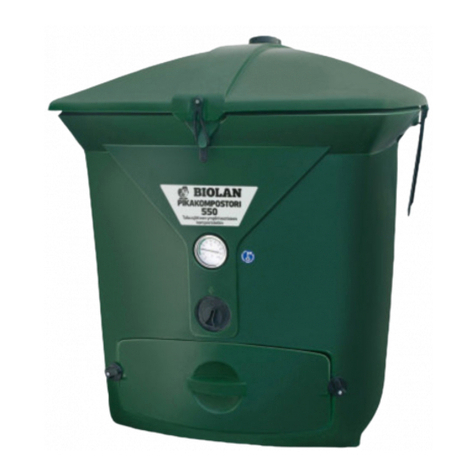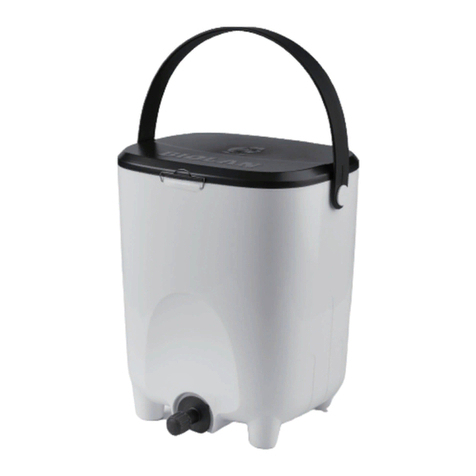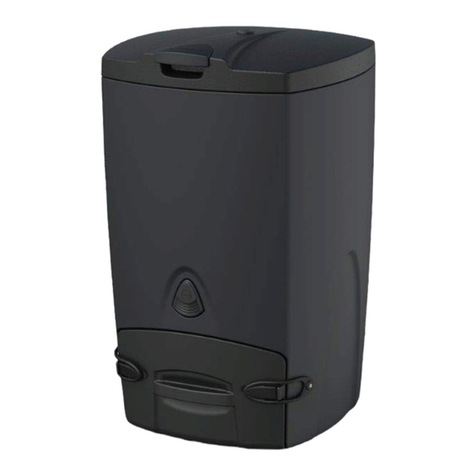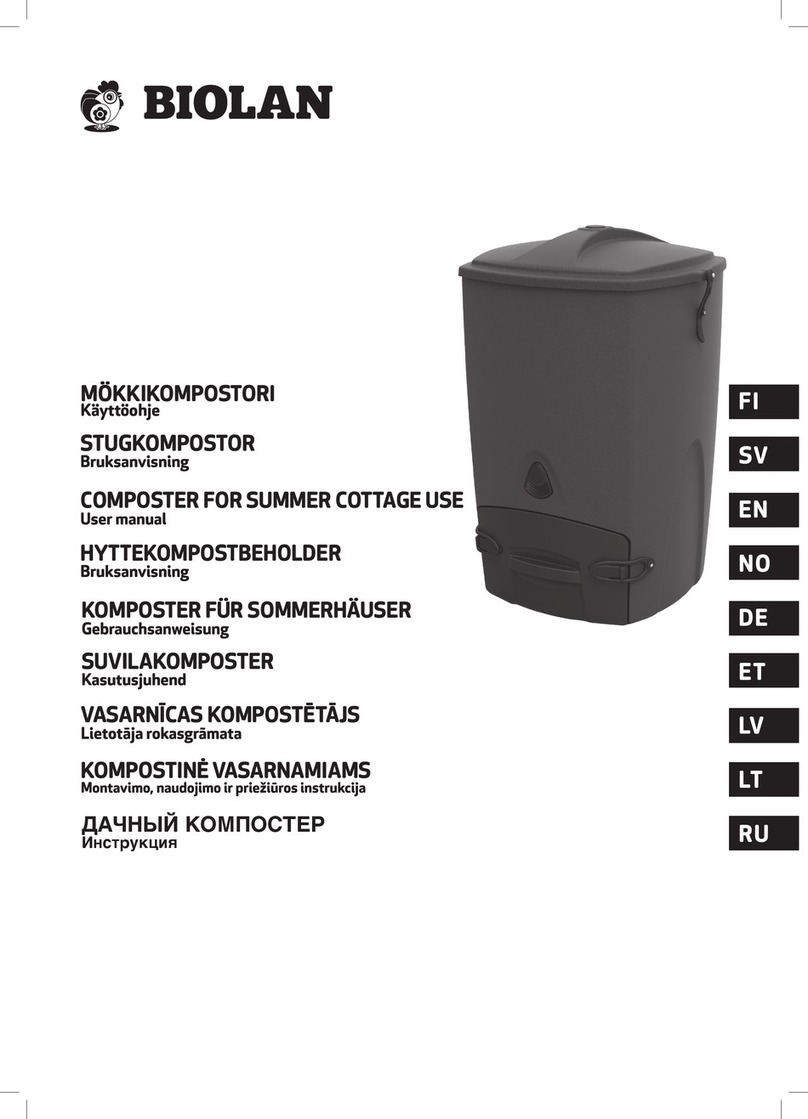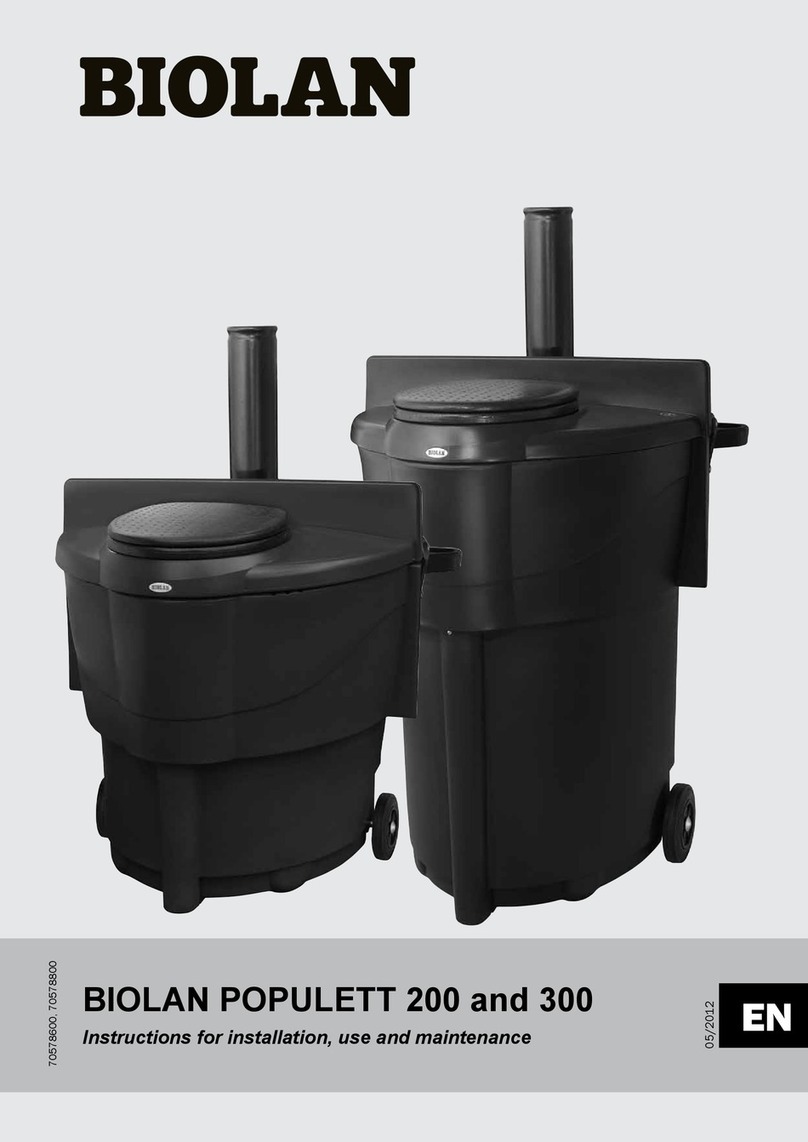
-5- BIOLAN OY
2. Composting
ProperuseoftheBiolanComposterallowsmoreefcientcompost-
ing of the mass and enables convenient use and emptying of the
composter. Owing to the thermal insulation and the ventilation sys-
temofthecomposter,thecompostingofthewasteismoreefcient.
Thecompostingstartsassoonasthereisasufcientamountof
waste in the composter, i.e. it is approximately level with the air
channel. After start-up the waste reaches the cover soil stage in
5-8 weeks.
2.1 Commissioning
1. Put on the bottom a layer about 5 cm thick (about 20 litres)
of Biolan Compost and Toilet Bulking Material.
2. Close the air valve in the front wall almost completely, i.e.
setthegure20 on the adjustment disc (part 12)pointing
upwards (see the point, How to adjust the air valve?)
2.2 Using the composter
1. Empty the biowaste bin into the composter. If you use biode-
gradable bags, empty the waste from the bag into the com-
poster and put the bag there separately.
2. Cover the waste with Biolan Compost and Toilet Bulking Ma-
terial (product number 5621). Depending on the wetness of
the waste, a suitable amount is about 1/3–1/2 of the amount
of waste added. The Biolan Compost and Toilet Bulking Ma-
terial absorbs odours and keeps the compost mass airy.
3. Continuethellinguntilthesurfaceofthewastereachesthe
level of the lower air pipe (part 5). Adjust the air valve in the
front wall in winter to the position 40 and in summer to the
position 50.
4. Continue the lling in accordance with the points 1–3 un-
til the surface of waste reaches the level of the upper air
pipe (part 4). Open the air valve properly – depending on the
outside air temperature (winter frost–summer heat) between
the positions 50–100. Sufcient amount of waste has ac-
cumulated, and the population of micro-organisms has been
created. The composting process starts, which can be es-
tablished from the rise of the temperature. Observe the loca-
tion of the thermometer (part 7) below the upper air pipe. So
the thermometer gives indicative information about the vari-
ous stages of the composting process and the temperature
during the hot phase.
5. Continuellingthecomposterasusual(points1–3)untilit
becomes almost full of waste. Open the emptying door (part
3) and empty (see the point 2.4)
2.3 Using the composter in frost
The heat in the composter is created by burning of the waste.
The thermal insulation of the Biolan Composter prevents the
heat from escaping and, by doing so, boosts the operation of the
composter and helps it stay unfrozen. The composter’s operation
tolerates mild frost provided, that waste is added continuously on
aweeklybasisandtheamountofwasteaddedissufcient.In
severe frost or if the toilet is rarely used, the compost mass cools
down and, in the winter, may even freeze. If the temperature of
the composter drops below 20 degrees centigrade:
1. Continuellingthecomposterasusual(seeparagraph2.2,
points 1–2).
2. If the frost is severe, adjust the air valve to a lower setting,
between positions 20–40.
3. Check that the air outlet valve (parts 10 and 11) has not fro-
zen. Dismantle the valve cover and remove any ice.
4. Empty the composter from the emptying door so as to pro-
vide more space for the waste and to stimulate the compost
mass by inputting oxygen and mechanical crushing.
How often shall I mix the Biolan Composter?
If operated duly, the Biolan Composter hardly requires any
mixing at all. The ventilation system of the composter com-
binedwithsufcientdosingoftheBiolanCompostandToilet
BulkingMaterialaresufcientforkeepingthecompostmass
adequately loose.
Do not mix the layers in different composting phases with
each other, but only mix the top layer at intervals of a few
weeks to the depth of 20–30 cm. Press the Compostmixer
into the compost mass from directly overhead and lift it back
the same way. Observe the location of the air pipes while mix-
ing the compost.
Do not place in the compost
• non-decomposing waste, such as plastic, glass, rubber,
leather
• toxic substances, such as rot-resistant or disinfecting
agents, paints, solvents, petrol, cigarette butts
• vacuum cleaner bags
• coloured advertising paper
• large amount of paper at one time
• ash or lime
Put into the household compost all biowaste, such as
• fruit and vegetable peels
• leftoversofmeatorsh,andotherfoodwaste
• coffeeorteagroundswithlterbags
• soft and wet papers
• crushed eggshells
• pet excrements
• naturalbresinsmallpieces
• biodegradable bags, open and separate from waste
• garden waste
• solid toilet waste
How to adjust the air valve?
The air supply to the composter is adjusted with the air valve
(part12)inthe frontwalloftheBiolanComposter.Theg-
ures 20–100 in the adjustment disc indicate in per cent (%)
how much the air valve has been
opened.
At the start of composting, adjust
the valve to the position 20. Then
thegure20isattheupperedge
of the adjustment disc and the
broadest part of the adjustment
handle points upward (see illus-
tration).
As the amount of waste increas-
es, adjust the air valve to a high-
er setting. You can turn the disc
in either direction.
If the composter is utilized frequently, keep the air valve in the
completely open or in the almost open position between 50–
100 (winter frost–summer heat). If it is rarely used, adjust the
air valve to a lower setting for breaks and during severe frost.
5. Bury hot water bottles or canisters in the surface layer of the
compost mass to provide warmer conditions for the micro-
organisms.
Freezing damages neither the unit nor the compost mass itself,
and the composting process will continue at the latest when the
sun begins to warm in spring.





